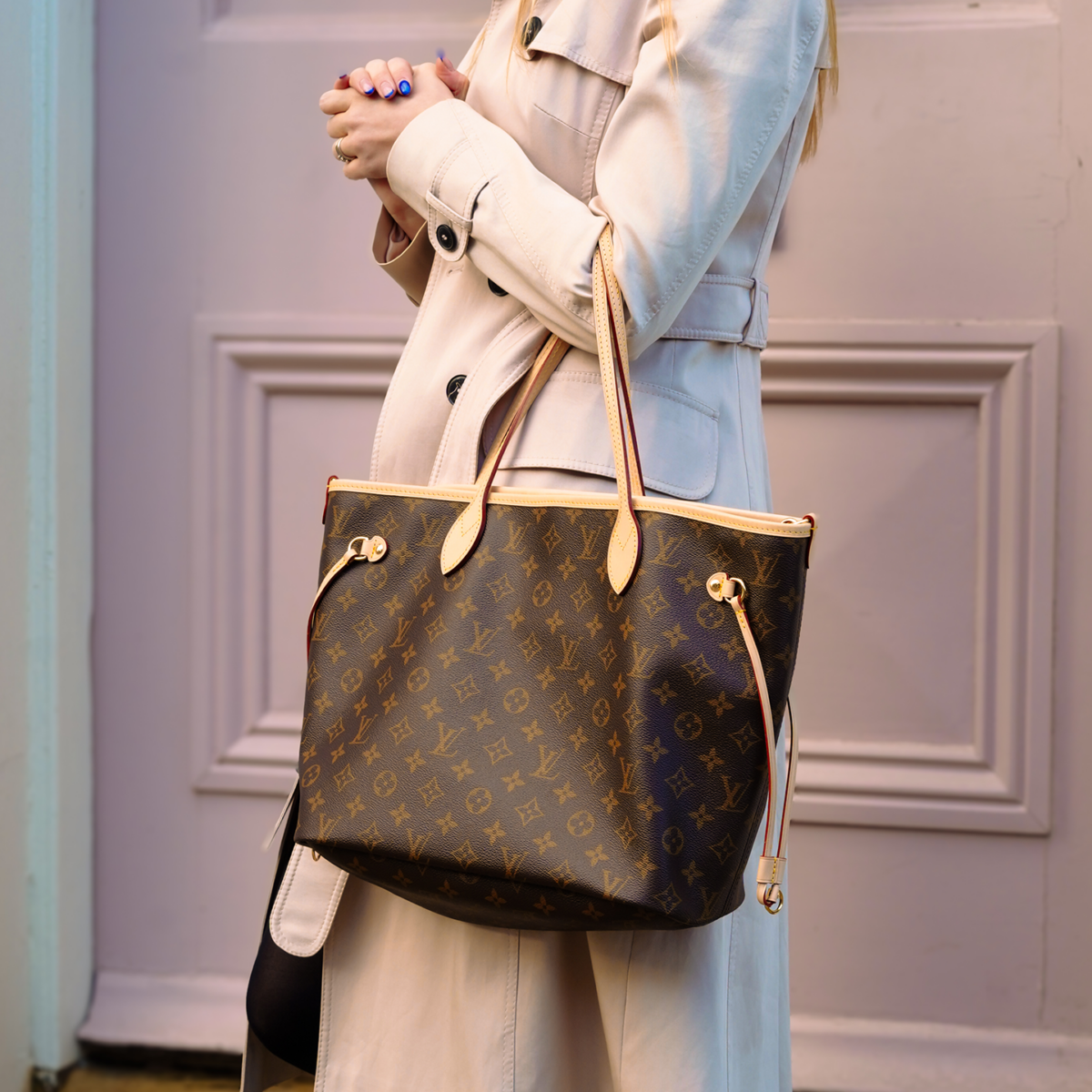April 16, 2025 | Posted in Blog

If someone asked you to think of a designer brand, Louis Vuitton would most likely be one of the first names to come to mind, right? Synonymous with luxury style and exclusivity, LV is one of the most recognisable brands in the world.
It’s been loved by generations of celebs, like Audrey Hepburn, Twiggy, Jennifer Aniston, Naomi Cambell, Bradley Cooper, Sienna Miller, Rihanna, Idris Elba and Sabrina Carpenter (the list is truly endless).
If you’ve ever wondered where Louis Vuitton started and what gives it a certain je ne sais quoi, we’re here to break it down for you. Keep reading to find out more about this legendary fashion house.
Louis Vuitton’s formula is simple – it’s just a combination of style and elegant craftsmanship. Though simple, Louis Vuitton has been pulling it off for decades. It earned its popularity with brave collaborations, creativity and a dedication to quality.
LV has always strived to set its own trends instead of following them, prioritising durability and design over the potential for mass production. When you get a product from Louis Vuitton, you know you’re getting an easily recognisable investment piece that’s built to last.
As the story of many a fashion house begins, LV’s roots are in France. Louis Vuitton himself was born in a remote village in the east, before leaving home at 13 and heading to Paris. He would then become an apprentice to the master box-maker Romain Maréchal.
Through this, Louis would become a highly skilled artisan, making custom luggage pieces for his clientele. His reputation preceded him and soon enough he was the personal box-maker and packer for Napoleon III’s wife, Eugenie the Empress of France.
This was in 1853 and by 1854, he was married to his wife, Clemence-Emilie Parriaux and had branched out on his own. His namesake brand was then born in his workshop near the Place Vendôme, where many fashion houses have lived. He introduced his innovative flat-lid trunk in 1858 and the rest is history.
So, how did Vuitton make his brand a success? His flat-lid trunk was a solution to wealthy travellers struggling to stack their luggage, utilising lighter more durable, waterproof leather – this reflected Louis’ vision. He was exceptionally good at spotting what people wanted but also needed.
The demand for Louis’s work became so high that he had to move to a bigger workshop. Ironically, this was near a railway station, perfect for enticing new customers needing luggage.
War in the 1870s suspended a lot of travel and his workshop was then ransacked. These were huge setbacks for Vuitton but he bounced back in style. After the war, he opened a new shop near the Opéra Garnier and the Louvre, beginning work on his collection of unique canvases.
Adding his signature and name to his products, LV would fight off the competition and imitators easily. Popularity grew and the first Louis Vuitton store outside of France opened in 1885. It was in Oxford Street, London and showed the brand’s staying power.
As Louis Vuitton grew his brand, he would start collaborating with his son, George. Together, they launched LV’s famous functional tumbler lock, which is still used to this day.
When Louis sadly died in 1892, George would take over. Honouring his father, he would create the classic intertwined ‘LV’ monogram with alternating diamond points and quatrefoil flowers pattern. This is now one of the most recognisable designer patterns in the world and remains effortlessly chic to this day.
Under George, Louis Vuitton became known in the States and its reputation as a luxury retailer flourished. In 1915, Coco Chanel noticed the brand. She would then approach George and request a handbag in the brand’s signature style. This was LV’s first venture into smaller leather goods but, for a fashion icon like Coco Chanel, it was a no-brainer.
This bag created for Coco was called the Alma and in the 1930s, she would allow LV to reproduce it, making it an instant smash hit. The 1930s would also introduce Louis Vuitton’s famous Keepall and Speedy bags.
Taking the 20th century by storm, the controls were then handed over to his son, Gaston-Louis in 1936 after George’s death. He would then expand its reach by designing a plethora of leather goods, not just luggage.
LV’s handbags were just as practical and high-quality as the luggage it was originally known for but they were elegant too, taking the accessory market by storm.
Audrey Hepburn was another influential figure who took a liking to the brand. She wanted a smaller version of the now best-selling Speedy so, In the 1960s, the Speedy 25 was born. She was pictured with it a lot, putting the Speedy on the map.
As the 20th century progressed, LV’s luxury handbags took over the brand’s image thanks to Gaston-Louis’ leadership. Then, in 1977, came his son-in-law, Henry Racamier, a man who made a few changes to Louis Vuitton as a brand.
Recamier’s vision included making Louis Vuitton bigger and better than ever. In 1987, Louis Vuitton would join with Moët-Hennessy, a French champagne and cognac producer. This merger would create LVMH, a holding company that would acquire other fashion-forward favourites like Celine, Fendi, Tiffany & Co, Bulgari, and Givenchy.
Yes, Louis Vuitton was not only making big fashion swings but also big business moves, solidifying itself as a household name.
Though he had taken LV truly global, Recamier would fall victim to a hostile takeover and was forced to leave the brand in 1990. Bernard Arnault would become CEO signalling the end of Louis Vuitton’s legacy as a family-run business.
Arnault would spend the next few decades ensuring that LVMH took over the fashion world and beyond.
The 90s was an exciting decade for Louis Vuitton as LVMH became the biggest luxury products company in the world. Its value as a company skyrocketed and the fashion house’s creations were consistently being seen in the arms of A-listers.
In 1996, the brand celebrated the 100th anniversary of its famous monogram canvas, working with specially selected designers to create a collection of one-of-a-kind pieces. These were then showcased across the world.
Marc Jacobs, before he’d launch his namesake fashion house, would become the creative director of Louis Vuitton in 1997. Thanks to his input, the brand would debut its first collection of clothing, with ready-to-wear pieces for both men and women.
In 2001, LV jewellery would also be launched, starting Louis Vuitton’s new millennium of innovation off right.
Yes, the naughties were a good time for Louis Vuitton. Its collaborations with Stephen Sprouse and Takashi Murakami resulted in iconic pieces like the Graffiti Speedy and the sought-after Cherry Blossom print respectively. Original versions of these now have an impressive resell value so, if you have one, count yourself truly lucky.
The 2000s were defined by celeb culture and, thanks to household names like Nicole Richie, Lindsay Lohan, and Paris Hilton, Louis Vuitton became associated with exclusivity. Anybody who was somebody had at least one LV bag.
From classic artisanship in its infancy to worldwide acclaim in this decade, Louis Vuitton remains a huge part of pop culture and fashion, with LVMH dominating multiple retail markets.
It has branched out from luggage but its accessories section is still the busiest part of any LV store. The bags have legendary status but LV suitcases have a hold on many fashion-lovers, proving it hasn’t lost its roots. It’s not just about the aesthetic, it’s about the craftsmanship that reflects decades of experience.
LV has upped its menswear game too. Kim Jones took over as men’s style director in 2008 and has created collections that have put LV on the menswear map. Notable male Louis Vuitton lovers include Hugh Jackman, Lewis Hamilton, Lenny Kravitz, and Justin Beiber.
Though the brand is still known for its elegant take on style, Jones would also champion its 2017 collaboration with streetwear brand Supreme, proving that LV could set new trends in multiple genres of fashion.
Of course, womenswear and handbags are still the brand’s main draw, but Louis Vuitton has branched out to a plethora of accessories and homeware pieces. There have even been several novelty bags from the brand, including the aeroplane bag, binoculars bag and fan bag.
Louis Vuitton continues its love affair with innovation and trendsetting, but it also isn’t afraid to go back to older ideas. In 2016, after 70 years without a new fragrance, LV launched a whole ‘Les Parfums’ collection, backed by a campaign starring Emma Stone.
Louis Vuitton is also under new leadership with Nicolas Ghesquière taking over from Marc Jacobs as women’s creative director in 2013. His first collaboration was LV’s biggest yet, with Nicolas carefully selecting six artists and designers to design their own pieces. Thanks to this, we got LV products from Christian Louboutin, Frank Gehry, Marc Newson, Cindy Sherman, Julie Verhoeven, and Karl Lagerfeld (who gave us the fabulous ‘Punching Trunk’).
The story of Louis Vuitton’s success has inspired many a designer and the fashion house is now heading towards two centuries of excellent craftsmanship. Louis Vuitton is still making an impact on runways and social media so, we’re looking forward to seeing what’s next for the brand.

There have been countless Louis Vuitton bags that we’d love to own, but there are definitely a few that stand out more than others. These are our favourites:
We had to start our list off strong with the Louis Vuitton Speedy. Staying faithful to the company’s travel accessory routes, this popular carry-on is lightweight and compact, plus it comes in several colourways, patterns and sizes.
Want a bag that combines practicality with effortless style? Then the Neverfall is for you. A newer edition to LV’s portfolio, being introduced in 2007, it’s known as a ‘house icon’ and we can see why. Its spacious design makes it the perfect everyday bag.
Inspired by hat bags, the Petite Boite Chapeau has a unique but wearable aesthetic. For those not convinced if it would work as an everyday accessory, look at how Selena Gomez styled it in 2019.
As iconic as it was in its inception in the 90s, the Pochette still has a hold on us, being easy to wear and bang on trend. You can buy new but vintage versions are incredibly popular right now and definitely worth the investment.
The one that started it all. Gaston-Louis Vuitton designed the Alma with Coco Chanel in 1934, with it being named after a Parisian bridge and inspired by the Art Deco movement. It’s almost structured like a bridge and comes in five sizes, including the newer BB and Nano versions.
The Louis Vuitton Keepall is the ideal weekend bag which isn’t shocking as LV does luggage so well. It comes with a luggage tag, padlock, and even keys and you can buy a version with and without straps. We love the simple but effective design.
We adore how the Petite Malle is influenced by the original Louis Vuitton trunk. The strap is detachable and the gold lock detail looks incredibly luxe. This would be a great option for date night.
If you’re looking to add a touch of luxury to your wardrobe with a quality designer bag (maybe even one from our list above), Your Dream Bag may be just what you’re looking for.
With our handpicked selection of designer handbags and accessories and easy-to-enter competitions, getting your hands on your next fashion fave is just a few clicks away.

Written by Eve Miller